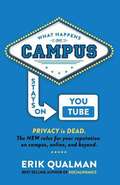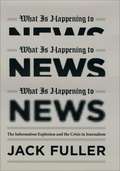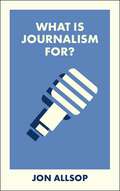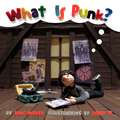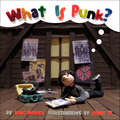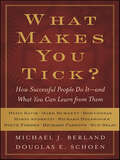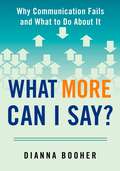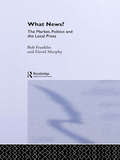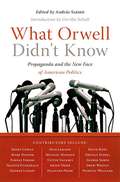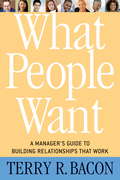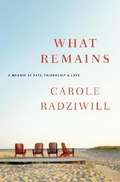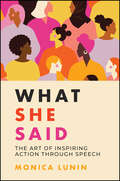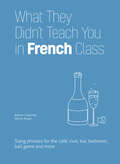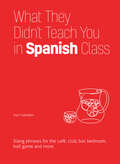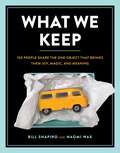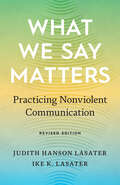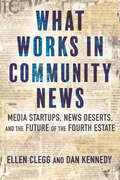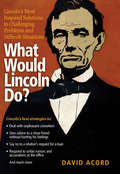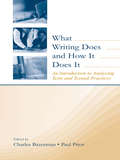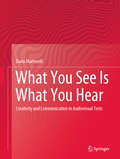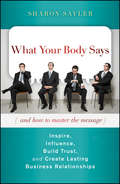- Table View
- List View
What Happens on Campus Stays on YouTube: Privacy Is Dead. The New Rules For Your Reputation On Campus, Online And Beyond
by Erik QualmanWhether we like it, love it, use it or hate it, escaping social media on any college campus is nearly impossible. When you arrive on campus, you will notice that social media isn't just a way to connect with friends but also a vast communication and marketing network for student organizations, internship opportunities and more! The purpose of this book is to not to tell you to avoid social media, but to help you start thinking about your digital reputation and providing you with some expert advice on using social media in a smart way. Even if you don't want to dive in right now, keep this book on your shelf for your future reference.
What Is Happening to News: The Information Explosion and the Crisis in Journalism
by Jack Fuller<P>Across America, newspapers that have defined their cities for over a century are rapidly failing, their circulations plummeting even as opinion-soaked Web outlets like the Huffington Post thrive. Meanwhile, nightly news programs shock viewers with stories of horrific crime and celebrity scandal, while the smug sarcasm and shouting of pundits like Glenn Beck and Keith Olbermann dominate cable television. <P> Is it any wonder that young people are turning away from the news entirely, trusting comedians like Jon Stewart as their primary source of information on current events? In the face of all the problems plaguing serious news, What Is Happening to News explores the crucial question of how journalism lost its way--and who is responsible for the ragged retreat from its great traditions. <P>Veteran editor and newspaperman Jack Fuller locates the surprising sources of change where no one has thought to look before: in the collision between a revolutionary new information age and a human brain that is still wired for the threats faced by our prehistoric ancestors. <P>Drawing on the dramatic recent discoveries of neuroscience, Fuller explains why the information overload of contemporary life makes us dramatically more receptive to sensational news, while rendering the staid, objective voice of standard journalism ineffective. <P>Throw in a growing distrust of experts and authority, ably capitalized on by blogs and other interactive media, and the result is a toxic mix that threatens to prove fatal to journalism as we know it. <P>For every reader troubled by what has become of news--and worried about what the future may hold--What Is Happening to News not only offers unprecedented insight into the causes of change but also clear guidance, strongly rooted in the precepts of ethical journalism, on how journalists can adapt to this new environment while still providing the information necessary to a functioning democracy.
What Is Journalism For? (What Is It For?)
by Jon AllsopWhat is at stake when journalism is threatened? Does society still need journalists? Journalism faces multiple threats today all over the world: economic decline, online disinformation, the rise of AI, authoritarian curbs on freedom of the press, and violence against journalists. In such a climate, it’s more urgent than ever to ask what journalism is for. Drawing on his experience as a journalist and media commentator, and on interviews with journalists from the US to Myanmar, Jon Allsop examines key concepts that constitute journalism’s role: good judgement, concern for truth and critical scrutiny of one or more communities. Along the way, he also considers the relationship between journalism and activism; whether journalists should aspire to change the world and whether they can be seen as champions of democracy.
What Is Punk?
by Eric MorseOne of The Globe and Mail's Best Books of 2015"A punk primer for the youngest set....Yi's incredibly detailed clay figures are a kinetic and inspired art choice. Their crazy creativity matches the expressive spirit of punk....As [Morse] points out, the best way to learn about punk it just to listen....If invested adults love the topic, a shared reading experience can't be beat."--Kirkus Reviews"Clay artist Yi molds...fantastically detailed Plasticine figures to create scenes of the birth of punk. Using a benign craft-project material for the skinny bodies and ragged clothing of Joey Ramone, Sid Vicious, and their rowdy, fist-waving audiences is very much in the spirit of punk (Plasticine is especially good for mohawks), and readers will spend long stretches inspecting her painstakingly modeled guitars, amplifiers, and safety pins."--Publishers Weekly"Why It's Wild: A history of punk music for kids illustrated in Gumby-esque claymation (minus the -mation)."--School Library Journal, 100 Scope Notes's "Wildest Children's Books of 2015""What is Punk? is fun, sophisticated and beautifully illustrated introduction to the music genre for kids--or adults."--New York Daily News"Reading What is Punk? to [my kids] made me feel as if I was passing on something truly significant. Morse and Yi have created a comprehensive and articulate...documentary about the roots of punk rock."--The Globe and Mail"An essential way to pass down to your son or daughter the lesson that pop culture can be political."--The Globe and Mail, 100 Best Books of 2015"A cool book of punk history for kids by Eric Morse, with great clay illustrations by Anny Yi."--Slate, Mom and Dad Are Fighting podcast"Eric Morse's book What Is Punk? explains the envelope-pushing genre to the younger set, and perhaps some adults, as well."--St. Louis Public Radio"Think Wallace and Grommet with liberty spikes and anarchy patches...While [Anny Yi's] images of Johnny Rotten and Henry Rollins are cute, they're presented as live action dioramas that are adorable, accurate and engaging."--San Diego City Beat"While What Is Punk? is undeniably a children’s book, it can serve as a history lesson for potential fans of any age....What Is Punk? exposes the reader to the rebellious sub-culture in a friendly, educative manner."--Alternative Press"A fun little book intended to serve as (rhyming) curriculum for little punks learning their Punk History 101....Sid, Glenn, and Milo meet Wallace and Gromit."--Razorcake"Pairing Yi's Wallace & Gromit-style clay pictorials with Morse's rhyming ride through the history of punk music across the globe, the children’s book is ready to raise the next generation of riot grrrls....You're going to want to give What Is Punk? as a gift at every baby shower this year. Just don't be surprised if your niece ends up bleaching her hair blonde and tearing up her leather jacket at age 6."--Bustle"Written by Trampoline House founder Eric Morse in classically Suessical iambic, the book is lusciously illustrated with photographs of Play-Doh recreations of all mommy's and daddy's favorite punk heroes: the Ramones, Iggy and the Stooges--and Debbie Harry, David Byrne, David Johansen, Tom Verlaine, and Lou Reed all standing in front of CBGBs."--Bedford & BoweryWhat Is Punk? is a must-read pop-culture primer for children--an introduction to the punk revolution, recreated in vivid 3-D clay illustrations and told through rhyming couplets.From London's Clash and Sex Pistols to the Ramones' NYC protopunk, from Iggy Pop to the Misfits, this volume depicts some of our culture's seminal moments and iconic characters. A delightful read for kids and parents alike, illustrated in a truly unique visual style, What Is Punk? lays the groundwork
What Is Punk?
by Eric MorseA wonderfully illustrated children's history of punk rock, from a progressive/idealistic perspective.—One of The Globe and Mail‘s Best Books of 2015 “A punk primer for the youngest set. . . . Yi’s incredibly detailed clay figures are a kinetic and inspired art choice. Their crazy creativity matches the expressive spirit of punk. . . . As [Morse] points out, the best way to learn about punk it just to listen. . . . If invested adults love the topic, a shared reading experience can’t be beat.” —Kirkus Reviews “Clay artist Yi molds . . . fantastically detailed Plasticine figures to create scenes of the birth of punk. Using a benign craft-project material for the skinny bodies and ragged clothing of Joey Ramone, Sid Vicious, and their rowdy, fist-waving audiences is very much in the spirit of punk (Plasticine is especially good for mohawks), and readers will spend long stretches inspecting her painstakingly modeled guitars, amplifiers, and safety pins.” —Publishers WeeklyWhat Is Punk? is a must-read pop-culture primer for children—an introduction to the punk revolution, recreated in vivid 3-D clay illustrations and told through rhyming couplets. From London’s Clash and Sex Pistols to the Ramones’ NYC protopunk, from Iggy Pop to the Misfits, this volume depicts some of our culture’s seminal moments and iconic characters. A delightful read for kids and parents alike, illustrated in a truly unique visual style, What Is Punk? lays the groundwork for the next generation of little punks.Part of Akashic’s Black Sheep YA imprint.
What Makes You Tick?: How Successful People Do It—and What You Can Learn from Them
by Douglas E. Schoen Michael J. BerlandIn the most challenging economy of our lifetime, where should you turn for guidance?To the stories of those who have made it—the leaders who battled adversity, forged their own paths,and succeeded . . . because they knew what made them tick.As people everywhere confront the global economic crisis, "success" may seem elusive at best, impossible at worst. Yet history proves that a new generation of success stories will likely emerge from this era of financial chaos. And this new book prepares you to be one of those success stories by analyzing the inner qualities that have propelled the forward-thinking leaders of our time: drive, determination, and self-awareness.As strategists for the internationally renowned consumer and political research firm Penn, Schoen & Berland Associates, Michael Berland and Douglas Schoen are experts in how successful people think . . . and how they win. Now they share what they've learned with firsthand accounts from some of the world's most successful people in nearly every field—including the founder of Starwood Resorts; a world-famous chef-restaurateur; the CEO of NBC Universal; a supermodel turned entrepreneur; the head of Estée Lauder; the commissioner of the National Hockey League; the president of Hearst Magazines; and the creator of CBS's 60 Minutes. Berland and Schoen have discovered that true success is about more than "winning." True success has an emotional quotient: it's about determining your innate strengths, deciding what you truly want, and striving tirelessly to achieve it. Berland and Schoen describe the five archteypes of success: visionaries, natural-born leaders, do-gooders, independence seekers, and independents who follow their dreams. In this unprecedented collection of stories from some of the most successful people in fashion, sports, entertainment, and business, Schoen and Berland demonstrate that success isn't about changing who you are; rather, it's about figuring out what makes you tick—and leveraging that knowledge to your advantage. This book shows through compelling first-person storytelling that the most successful people understand their own natural abilities and how to use their best qualities to create a fulfilling life—and then tells you how to do the same.
What More Can I Say?
by Dianna BooherAn essential guidebook for honing business communication skills... Communications expert Dianna Booher provides an essential nine-point checklist for success in the art of communication and persuasion--for building solid relationships, and for increasing credibility in the workplace. With lessons from politics, pop culture, business, family life, and current events, the book identifies common reasons that communicators fail to accomplish their goals, along with examples and analyses of messages that succeed and those that fail.
What News?: The Market, Politics and the Local Press (Communication and Society)
by David Murphy Bob FranklinA survey of the role and the future prospects of the local press in the 1990s. The authors also take into account the radical changes the local press have been through with new technology and the proliferation of free newspapers.
What Orwell Didn't Know: Propaganda and the New Face of American Politics
by Andras Szanto[Back of Book] Manipulation. Bias. Spin. Dishonesty. Half a century after George Orwell's death and six decades after his classic essay, "Politics and the English Language"-in which he tied the corrosion of language to the corruption of politics-American public life is riddled with the symptoms of obfuscation and doublespeak Orwell so vividly diagnosed. A Big Brother- style dystopia has not come to pass, but tools are available to spinmeisters and image-makers that allow them to detach politics from reality on a daily basis. Twenty prominent voices consider the outlooks for reality-based politics in this anthology. From the use of deceptively murky jargon, to the emotional pull of phrases like the "War on Terror," to the rise of infotainment and pseudo-science, to the disinclination of big media to provide real news, these writers address unsettling developments in today's public discourse. Reflecting on Orwell, they shed new light on the power of politicians and the media to deceive and to repair, to fracture and to unite American democracy.
What People Want: A Manager's Guide to Building Relationships That Work
by Terry R. BaconWhat People Want reveals the truth about what it takes to build employee-manager relationships that matter—both to the people involved and to the bottom line. Packed with fascinating results from first-of-its-kind research, this road map through today’s workplace of changing demographics, diversity, and difference offers a multitude of tools and advice for building trust, creating a respectful environment, being sensitive to others, setting the right tone, and developing the kinds of relationships that result in lower turnover, higher productivity, and greater employee satisfaction.
What Remains: A Memoir of Fate, Friendship, and Love
by Carole RadziwillMemoir about a girl from a working-class town who becomes an award-winning television producer and marries a prince, part fairy tale, part tragedy.
What She Said: #1 Award Winner: The Art of Inspiring Action through Speech
by Monica Lunin**Winner of the Communications and Sales Book of the Year and Winner of Cover Design at the Australian Business Book Awards 2022**Learn how spoken words can change a mind, a community and the world with this collection of remarkable speeches by women What She Said is an inspiring collection of speeches from passionate and persuasive women from around the world and throughout history. The included speakers come from diverse cultural and ethnic backgrounds, ages, and education levels, demonstrating how women from all walks of life can use the power of speech to bring change. Author Monica Lunin has curated and analysed 40 of the greatest speeches made by strong and empowering women from all around the world. From Queen Elizabeth I to Maya Angelou, Greta Thunberg, Julia Gillard, and Michelle Obama, What She Said shows not only what was said but also how the speech worked and why it was effective. In this insightful exploration of female wit, persuasion, and leadership, you’ll find an extract of the speech, a biography of the speaker and a breakdown of the qualities that made it so remarkable. You’ll learn how these women: inspired, moved, and persuaded an audience understood and empathised with a crowd effectively argued a position opened hearts and minds shared thoughts and insights. Across 10 chapters, each representing a different theme—from inspiration to activism to storytelling—What She Said will teach you to harness and leverage the power of the spoken word, offering the voices and tools to help you bring about the change you want to see in your world.
What They Didn't Teach You in French Class: Slang Phrases for the Café, Club, Bar, Bedroom, Ball Game and More (Dirty Everyday Slang)
by Henry Rowe Adrien ClautrierDrop the textbook formality and chat with the locals in France’s everyday language—from common words for meeting and greeting to colorful insults. Sipping a café au lait at a sidewalk bistro . . . Getting down at Paris’s hottest club . . . Cheering on Les Bleus at the stadium . . . Packed with slang words, phrases and expressions not found in any textbook, this fun-to-read handbook teaches the casual, everyday language heard in the cafes, bars, and streets of France. No one actually speaks the formal French taught in school, which makes this book a must-have for anyone looking to chat with the locals without sounding like a robot. This handy phrasebook is perfect for travelers and students who want to fill the gap between the French they are learning in class and what is really spoken in France.What’s up? Ça va?She’s totally hot. Elle est bandante.This party is lit! Cette bringue est enflammée!That brie smells funky. Ce brie sent putain de drôle.Wanna French kiss? On se roule une pelle?That ref is a moron. L’arbitre est un abruti.
What They Didn't Teach You in German Class: Slang Phrases for the Café, Club, Bar, Bedroom, Ball Game and More (Dirty Everyday Slang)
by Daniel ChaffeyThe down and dirty phrases you need to speak German like a local—from tech speak to talking smack with fellow sports fans.Drinking a Hefeweizen at a Biergarten . . . Dancing at Berlin’s hottest club . . . Cheering for the local soccer team at the Stadion . . . Ditch the textbook dialogues and learn to really engage in meaningful (and sometimes meaningless) conversations with lifelong German speakers. From getting a date to hailing an Uber driver, you’ll learn helpful phrases and info to break down the language and cultural barrier. What’s up? Wie geht’s?He/She is a real hottie. Er/Sie ist eine ganz heiße Nummer.What’s on tap? Was gibt’s vom Fass?I ordered the Currywurst. Ich bin den Currywurst.Do you wanna cuddle? Willst Du kuscheln?Gooooooal! Toooooor!
What They Didn't Teach You in Spanish Class: Slang Phrases for the Café, Club, Bar, Bedroom, Ball Game and More (Dirty Everyday Slang)
by Juan CaballeroLearn cool slang, funny insults and all the words you won’t find in a normal textbook in this guide to informal, conversational Spanish.You’ve taken Spanish lessons and learned all kinds of useful phrases. You know how to order dinner, get directions, and ask for the bathroom. But what happens when it’s time to drop the textbook formality? To really know a language, you need to know it’s bad words, too. You need this book.From common slang and insulting curses to explicit sexual expressions, this volume teaches the kind of Spanish heard every day across Latin America. Learn to sound like a native speaker with phrases like: • What’s up? ¿Qué tal?• What a hottie! ¡Que cuerazo!• Let’s pound these shots. Tráguemonos estos traguitos.• That ref sucks. Es una mierda ese árbitro/a.• I’m craving all-you-can-eat tacos. Me antoja un poco de taquiza libre.• Do you wanna hook up? ¿Quieres ligar?
What We Had: A Memoir
by James ChaceIn an affectionate memoir of growing up amid genteel proverty, Chace describes the events, nostalgia, and obsessions that shaped his childhood, his eccentric relatives, his Harvard education, his stint as a CIA informat, and his later career
What We Keep: 150 People Share the One Object that Brings Them Joy, Magic, and Meaning
by Bill Shapiro Naomi WaxWith contributions from Cheryl Strayed, Mark Cuban, Ta-Nahesi Coates, Melinda Gates, Joss Whedon, James Patterson, and many more--this fascinating collection gives us a peek into 150 personal treasures and the secret histories behind them. All of us have that one object that holds deep meaning--something that speaks to our past, that carries a remarkable story. Bestselling author Bill Shapiro collected this sweeping range of stories--he talked to everyone from renowned writers to Shark Tank hosts, from blackjack dealers to teachers, truckers, and nuns, even a reformed counterfeiter--to reveal the often hidden, always surprising lives of objects.
What We Say Matters
by Judith Hanson Lasater Ike K. LasaterFor yoga teacher Judith Hanson Lasater and her husband, mediator Ike K. Lasater, language is a spiritual practice based on giving and receiving with compassion. In What We Say Matters, they offer new and nurturing ways of communicating. Long-term students of yoga and Buddhism, the authors here blend the yoga principle of satya (truth) and the Buddhist precept of right speech with Marshall Rosenberg's groundbreaking techniques of Nonviolent Communication (NVC) in a fresh formula for promoting peace at home, at work, and in the world. The authors offer practical exercises to help readers in any field learn to diffuse anger; make requests rather than demands or assign blame; understand the difference between feelings and needs; recognize how they strategize to get needs met; choose connection over conflict; and extend empathy to themselves and others.
What We Say Matters
by Judith Hanson Lasater Ike K. LasaterFor yoga teacher Judith Hanson Lasater and her husband, mediator Ike K. Lasater, language is a spiritual practice based on giving and receiving with compassion. In What We Say Matters, they offer new and nurturing ways of communicating. Long-term students of yoga and Buddhism, the authors here blend the yoga principle of satya (truth) and the Buddhist precept of right speech with Marshall Rosenberg's groundbreaking techniques of Nonviolent Communication (NVC) in a fresh formula for promoting peace at home, at work, and in the world. The authors offer practical exercises to help readers in any field learn to diffuse anger; make requests rather than demands or assign blame; understand the difference between feelings and needs; recognize how they strategize to get needs met; choose connection over conflict; and extend empathy to themselves and others.
What We Say Matters: Practicing Nonviolent Communication
by Judith Hanson Lasater Ike K. LasaterLearn how to communicate with compassion and choose language that reflects your personal values and aims with this essential guide to Nonviolent Communication.Judith Hanson Lasater and Ike Lasater, long-term students of yoga and Buddhism, had studied the concepts of satya (truth) and the Buddhist principle of right speech for years but it was not until they began practicing Marshall Rosenberg&’s techniques of Nonviolent Communication (NVC) that the concept of speech as a spiritual practice became real for them. In What We Say Matters, the authors describe their personal journey through NVC, and detail how speech becomes a spiritual practice when you give and receive with compassion all the time--at home, at work, and in the world. They introduce the basics of NVC with clear explanations, personal examples, exercises, and resources. Some of the skills you&‘ll learn include: Extending empathy to yourself and others Distinguishing between feelings and needs Making requests rather than demands Creating mutually satisfying outcomes And many moreThis new edition includes updated resources and a preface by Judith Hanson Lasate.
What Works in Community News: Media Startups, News Deserts, and the Future of the Fourth Estate
by Dan Kennedy Ellen CleggA groundbreaking study of the journalism startups that are solving the local news crisis one community at a timeA must-read for activists, entrepreneurs, and journalists who want to start local news outlets in their communitiesLocal news is essential to democracy. Meaningful participation in civic life is impossible without it. However, local news is in crisis. According to one widely cited study, some 2,500 newspapers have closed over the last generation. And it is often marginalized communities of color who have been left without the day-to-day journalism they need to govern themselves in a democracy.Veteran journalists Ellen Clegg and Dan Kennedy cut through the pessimism surrounding this issue, showing readers that new, innovative journalism models are popping up across the country to fill news deserts and empower communities. What Works in Community News examines more than a dozen of these projects, including:Sahan Journal, a digital publication dedicated to reporting on Minnesota&’s immigrant and refugee communities;MLK50: Justice Through Journalism, a nonprofit news outlet in Memphis, TN, focused on poverty, power, and public policy;New Haven Independent / WNHH / La Voz Hispana de Connecticut, a digital news project that expanded its reach in the New Haven community through radio and a Spanish-language partnership;Storm Lake Times Pilot, a print newspaper in rural Iowa innovating with a hybrid for-profit/nonprofit model; andTexas Tribune, once a pioneering upstart, now one of the most well-known—and successful—digital newsrooms in the country.Through a blend of on-the-ground reporting and interviews, Clegg and Kennedy show how these operations found seed money and support, and how they hired staff, forged their missions, and navigated challenges from the pandemic to police intimidation to stand as the last bastion of collective truth—and keep local news in local hands.
What Would Lincoln Do?
by David AcordLincoln's Most Inspired Solutions to Challenging Problems and Difficult SituationsWhat Would Lincoln Do?is a fun and insightful guide to common problems people face and how the Great Emanicaptor would tackle them. Using actual tactics Lincoln recorded in his letters and speeches, readers will learn how to: Deal with unpleasant coworkers Give advice to a close friend without hurting his feelings Say no to a relative's request for a loan Respond to unfair rumors and accusations at the office Clear the air after an argument Stand your ground in difficult circumstances Inspire the people around youHow much easier would it be to tackle your everyday problems if you could have Lincoln advising you?What Would Lincoln Do?is a must-have guide for Lincoln fans and anyone wishing to benefit from the advice from one of history's top leaders.
What Writing Does and How It Does It: An Introduction to Analyzing Texts and Textual Practices
by Paul Prior Charles BazermanIn What Writing Does and How It Does It, editors Charles Bazerman and Paul Prior offer a sophisticated introduction to methods for understanding, studying, and analyzing texts and writing practices. This volume addresses a variety of approaches to analyzing texts, and considers the processes of writing, exploring textual practices and their contexts, and examining what texts do and how texts mean rather than what they mean. Included are traditional modes of analysis (rhetorical, literary, linguistic), as well as newer modes, such as text and talk, genre and activity analysis, and intertextual analysis. The chapters have been developed to provide answers to a specified set of questions, with each one offering:*a preview of the chapter's content and purpose; *an introduction to basic concepts, referring to key theoretical and research studies in the area;*details on the types of data and questions for which the analysis is best used; *examples from a wide-ranging group of texts, including educational materials, student writing, published literature, and online and electronic media; *one or more applied analyses, with a clear statement of procedures for analysis and illustrations of a particular sample of data; and*a brief summary, suggestions for additional readings, and a set of activities. The side-by-side comparison of methods allows the reader to see the multi-dimensionality of writing, facilitating selection of the best method for a particular research question. The volume contributors are experts from linguistics, communication studies, rhetoric, literary analysis, document design, sociolinguistics, education, ethnography, and cultural psychology, and each utilizes a specific mode of text analysis. With its broad range of methodological examples, What Writing Does and How It Does It is a unique and invaluable resource for advanced undergraduate and graduate students and for researchers in education, composition, ESL and applied linguistics, communication, L1 and L2 learning, print media, and electronic media. It will also be useful in all social sciences and humanities that place importance on texts and textual practices, such as English, writing, and rhetoric.
What You See Is What You Hear: Creativity and Communication in Audiovisual Texts
by Dario MartinelliWhat You See Is What You Hear develops a unique model of analysis that helps students and advanced scholars alike to look at audiovisual texts from a fresh perspective. Adopting an engaging writing style, the author draws an accessible picture of the field, offering several analytical tools, historical background, and numerous case studies. Divided into five main sections, the monograph covers problems of definitions, history, and most of all analysis. The first part raises the main problems related to audiovisuality, including taxonomical and historical questions. The second part provides the bases for the understanding of audiovisual creative communication as a whole, introducing a novel theoretical model for its analysis. The next three part focus elaborate on the model in all its constituents and with plenty of case studies taken from the field of cinema, TV, music videos, advertising and other forms of audiovisuality. Methodologically, the book is informed by different paradigms of film and media studies, multimodality studies, structuralism, narratology, “auteur theory” in the broad sense, communication studies, semiotics, and the so-called “Numanities.” What You See Is What You Hear enables readers to better understand how to analyze the structure and content of diverse audiovisual texts, to discuss their different idioms, and to approach them with curiosity and critical spirit.
What Your Body Says (And How to Master the Message)
by Sharon SaylerTrain your body to communicate with confidence and clarity-have your body match what your mouth says...The popular phrase "leading from influence" takes for granted that influence derives chiefly from verbal communication. However, communication is about more than words. To get to the next level in your career, you must communicate with your entire self.What Your Body Says gives you the straight-up "how-to" on unifying what you say with what you do, allowing you to better connect with other people and reach your full leadership potential. It gives you a clear and simple process to follow, all drawn from an intense study of how language impacts people's lives and emotions. Filled with useful tools, strategies, and techniques, this book gives you the key toSpeak intelligently while looking smart, engaging and realDeliver unpleasant messages without pain or guiltHaving a committee meeting and getting something doneAnd moreWritten by Sharon Sayler, a highly accomplished expert in marketing, presentations, and body language, What Your Body Says is the only guide you need to achieve the competitive edge in your personal and business communication style.
